Time zone IST (UTC+5:30) Area code 04735 | State Kerala Elevation 333 m (1,093 ft) PIN 689662 | |
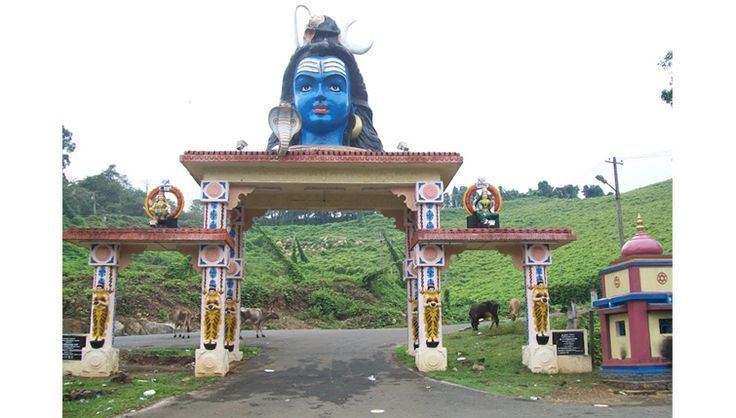 | ||
Nilakkal (/-ˈnɪləkəl/), also spelled Nilackal, is a remote ghat region located in the Goodrical range of Ranni forest division in Pathanamthitta District in the Indian state of Kerala. The place is noted mainly as an edathavalam or halting-place for the Ayyappa devotees during Sabarimala pilgrimage. Administratively, it falls under the Perunad grama panchayath in Ranni tehsil. Sabarimala, the famous Hindu pilgrim centre in South India is located at a distance of 23 km (14 mi) in the north-east hilly region of Nilakkal. One of the Seven and half Churches believed to be established by St. Thomas is located in Nilakkal.
Contents
- Nilakkal check dam issue sabarimala
- Etymology
- History
- Destruction of Nilakkal
- Geography
- Location
- Sree Mahadeva temple
- Palliyarakkavu Devi temple
- St Thomas ecumenical church
- The diocese of Nilakkal
- Discovery of a stone cross
- Formation of Nilakkal Action Council
- Chief representatives of Hindu organizations
- Beginning of struggles
- Solving the problems
- Places of interest
- Agriculture
- Climate
- Nilakkal base camp
- Health and education
- Nearby hospitals
- Educational institutions
- Road
- Railway
- Airport
- Nearby places
- References

Nilakkal check dam issue sabarimala
Etymology

Pursuant to some historical records, the name Nilakkal is associated with Nilavaaya, considered to be the presiding deity of old Shasta temple (present Sabarimala) at the forest interiors. While some other records has it that the name Nilakkal came from "Nilakkal thavalam". The place has an alternate name Chayal which denotes a place sloping towards Pamba river. But in another context, Chayal (in Hebrew) is referred to someone who is left alone.
History
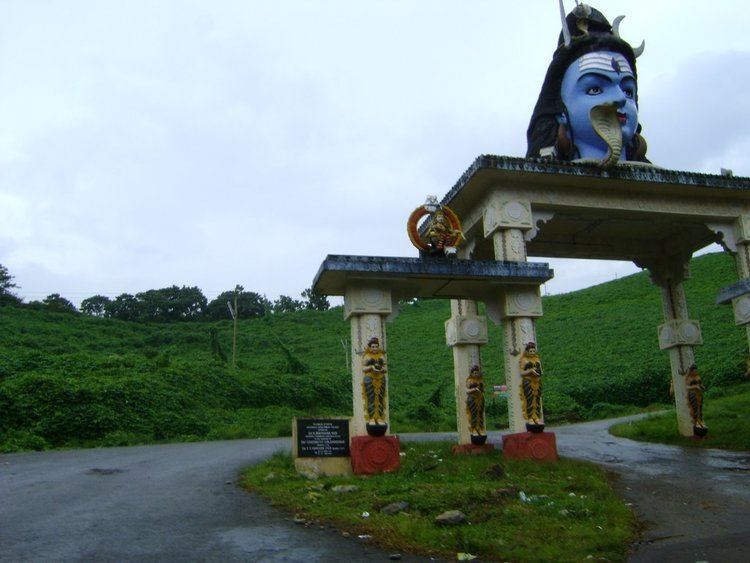
The historical background of Nilakkal was based on its geographical position, which date backs to the ancient times. Kerala had age-long trade relations with Pandiyas and Cholas through a trade route passed through Nilakkal. It was a well established populous trade center during the first century AD, primarily exporting spices such as cinnamon, ginger, pepper and forest products like timber and ivory. The place at that time was commonly known as Nilakkal thavalam and it was connected to ports like Muziris (present Kodungalloor) and Purakkad. Merchants who traveled with their trade items had a sojourn at the thavalam. In the later stages, the region came under the possession of Vel kings of Ay kingdom (later became Venad). When the Pandalam dynasty was established in c. 79 CE, it came under the rule of Pandalam rulers. St. Thomas, an apostle of Jesus Christ accompanied by Habban arrived there in 54 AD and baptized almost 1100 people, which eventually led to the emergence of a Christian community. Many churches were established in the regions including Nilakkal and Thulappally by the apostle's visit. Even today, the places like Plappally and Thulappally indicates it. The head Church of all these small Churches were known as Thalappally which later became Thulappally, which is about 11 km from Nilakkal.
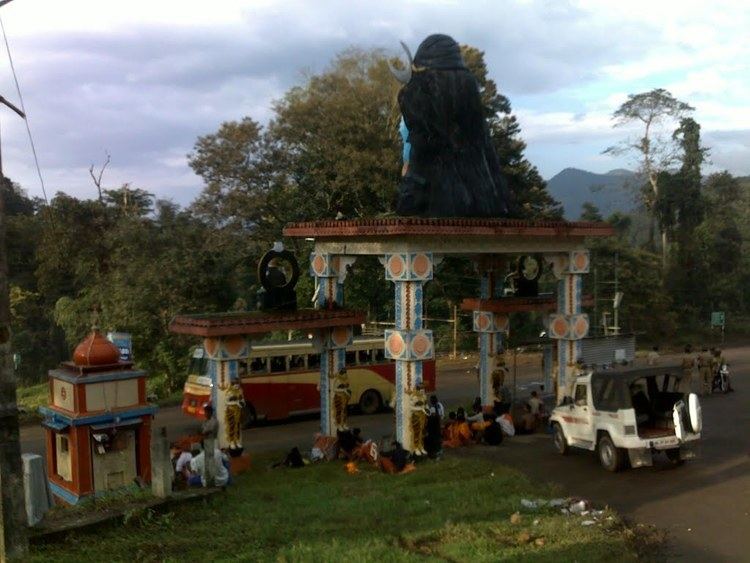
At the beginning of first century AD, Buddhists and Christians settled in Nilakkal considered it as a place of worship. Historical records indicates that Mar sabor, a bishop from Mar Mattai monastery of Ninveh had an ashram here known by the name Chayal ashram ('Chayal' in Hebrew means people who stay alone). Towards the end of his life, he spend his time in meditation and was buried here in a hill named Sabor mala which is thought to be the present Sabarimala. In 1902, when British rule was prevailing in India, the remains of an ancient dilapidated church and a cemetery were accidentally discovered from the forest interiors. An inscription was also discovered, probably written in Roman or Greek letters which hasn't deciphered yet. These discoveries date backs to the establishment of a church there by St.Thomas back in 54 AD. It is considered as one among the Seven and a half churches (Ezharappallikal) in Kerala. Thus the Christian community in Kerala consider Nilakkal as a holy place. Still there are no factual evidences regarding the arrival of St.Thomas in Kerala. But the old metal plates, Marthoma charitham, Ramban songs and Veeradiyan songs indicates certain references about the apostle's arrival and missionary works in Nilakkal.
Destruction of Nilakkal
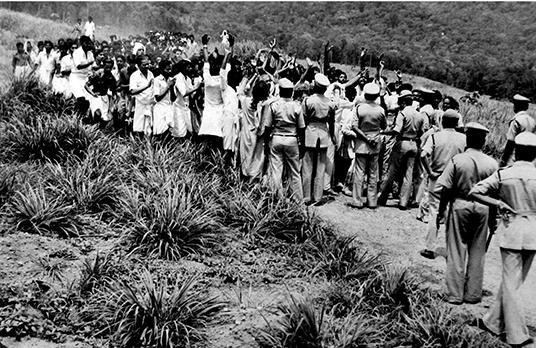
A group of plunderers under 'Vikram Puli Thevar' and 'Paraya Pattam' plundered the temples, churches and houses in the high ranges between 1253 and 1299 AD. Fearing the chaotic situation and catastrophic events, many families settled there fled through the hill tracks and rivers and eventually migrated to places like Kanjirappally, Poonjar, Niranam, Ayroor, Ranni and Thumpamon. The present day descendants of those families believes in their origin from Nilakkal. The place once a flourished trading center was completely demolished by c.1341 AD. The Syrian Christians used to conduct pilgrimage to Nilakkal Church and Chayal ashram till the complete destruction of the place. Several natural calamities during the first half of 14th century, the prolonged Chera - Chola war in the end of 12th century, introduction of Islam and epidemics like plague etc. played a big role in the demolition of Nilakkal. Some palmleaf records and other documents points out that the "Thulukkapada" destroyed Nilakkal. In course of time, Nilakkal became a forested and abandoned place.
Geography
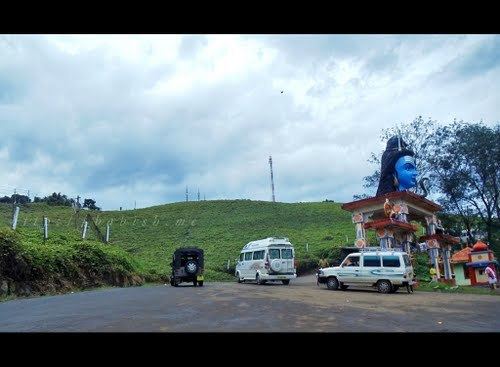
Predominately it is a remote hilly area classified as Malanad (geographic division of Kerala) totally surrounded by dense reserve forests and small scale rubber plantations. Geographic coordinates of the place is 9°22′49.43″N 76°59′52.6″E. The region has an altitude ranging from 330 m (1,080 ft) above mean sea level. A sizeable portion is covered by thick reserve forests of Western Ghats mountain ranges and rubber plantations. The holy river Pamba, flows westward through the northern part of Nilakkal and finally merges with Vembanadu Lake.
Location
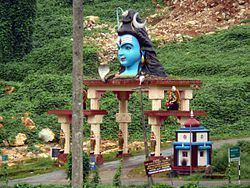
Nilakkal lies in the eastern part of Pathanamthitta district and west to Sabarimala near the Western Ghats forests. It is located on the main trunk road leading to Sabarimala temple. Pathanamthitta town is about 42 km (26 mi) and Kottayam about 78 km (48 mi). Chittar (27 km) and Angamoozhy (7 km) are the nearby townships.
Sree Mahadeva temple
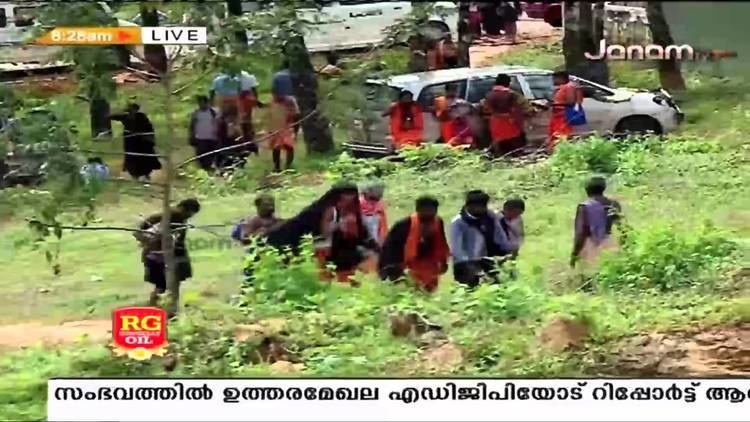
The old shrine at Nilakkal is currently administered by Travancore devaswom board (TDB). During Sabarimala pilgrimage, lots of pilgrims visit the temple to have a sojourn and worship. On this occasion, Nilakkal will be crowded by a large number of pilgrims. The temple was built in 1946. It is located just 1 km from the main highway that leads to Sabarimala. Lord Shiva is the presiding deity and he is believed to be in two moods, Ugramoorthy (fierce) and Mangala pradayakan (auspicious). A common belief is that Lord Shiva is showering his blessings to his son Lord Ayyappa to fight against all evil spirits while throwing all anger to the evils. There is only two Upa Prathishtas (sub-deities) here, Lord Kannimoola Ganapathi and Nandi. Three Poojas are held here every day. Special weekly days are Sunday, Monday and Friday. The Maha Shivaratri held annually is one of the noted festivals of the temple.
Palliyarakkavu Devi temple
It is situated near the Shiva temple. Devi presides here, who is considered as the Mother of Lord Ayyappa. Pilgrims make offerings to Devi for welfare and sake. The Irumudi kettu nirakkal (a ritual related to Sabarimala pilgrimage) is performed here by the pilgrims after the Nayattu vili (a narrative song). Three poojas are held every day. Aravana payasam is the main offering to Devi.
St. Thomas ecumenical church
Saint Thomas, who was an apostle of Jesus Christ established Seven and Half Churches in Kerala which was famed as Ezharappallikal. St. Thomas Ecumenical Church near Angamoozhy is one of them. It is referred as 'Arappally' or half-church. The church is an example of the unity of the Christian churches and also of the communal harmony. The church trust proved that unity among the churches can be maintained and at the same time give respect to the sentiments of the faiths of other religions. The main message which the church provides is of 'love, peace and fraternity'. The church is believed to be constructed in the year 54 AD. This church has the importance that it is the first Ecumenical church in the world and has been dedicated by all the denominations as an example of heritage by St. Thomas. The church is located in the interior part of the Sabarimala hills, while all the other churches built by St. Thomas are near to the coastal areas viz. Kokkamangalam, Paravoor, Palayoor, Thiruvithamkode. Even though there is no historical evidence of the missionary work of St. Thomas in Nilakkal, some assumptions of his establishment of a church in this place is written in old metal plates and other historian writings. Since the old church is in a dilapidated stage, a new church has been constructed in a site not far from it.
The diocese of Nilakkal
Nilakkal diocese was formed on August 15, 2010, by the order issued by H.H Baselios Mar Thoma Didymos I, the Catholicos cum Malankara metropolitan. The first metropolitan of the diocese is H.G.Dr Joshua Mar Nicodimos. This newly formed diocese, comprising Kottayam and Pathanamthitta districts, has 39 parishes including almost 2953 families. These parishes are organised into five ecclesiastical districts such as Ayroor, Vayalathala, Ranni, Nilakkal and Kanakappaalam. The diocese has its headquarters at Ranni, named St. Thomas aramana, and also engages in charitable activities such as helping the poor and needy in and around the diocese.
Discovery of a stone cross
The struggles marked its beginning on March 24, 1983, with the discovery of a stone cross on the Kerala Farming Corporation's (KFC) private land, just 200 m (0.20 km) south to the Nilakkal Mahadeva temple. Fr. Mathew Anthiyakulam, who was the chief priest of the nearby Pambavalley church arrived at the spot by singing hymns, with his two jeep loads of followers. Immediately they erected a thatched shed in shape of a Church and daily prayers were started. To the Catholic community in Kerala, it was clear that this was the exact spot where a Church was built in the first century by St.Thomas, the apostle.
Formation of Nilakkal Action Council
The prayer procession held on April 24 under the guidance of Kummanam Rajasekharan (Hindu activist) and Sathyananda saraswathi (Hindu spiritual leader) marked the beginning of struggles. A meeting was held at Poorna auditorium, Thiruvananthapuram for various representatives of Hindu organizations with P. Keralavarma Raja as moderator. About 27 representatives actively participated in the meeting in which they decided to go on with struggles until the cross was removed from the spot. An action council was formed with Kummanam Rajasekharan as General-Convener, Swami Sathyananda Saraswathi as Chairman, J.Sisupalan as Convener and including 31 other members. The council had its first meeting at Chengannur on 28 April.
Chief representatives of Hindu organizations
Meanwhile, the Hindus grouped with the Vishal Hindu Sammelan to fight the Catholic demand for a church. At the same time, the crusade for the church was given a thrust by the formation of the Nilakkal Action Council under the auspices of the All Kerala Catholic Congress, led by rubber tycoon M.D.Joseph.
Beginning of struggles
On May 19, when Karunakaran's government finally granted 1 hectare (2.5 acres) of land for a church at Nilakkal, a shocked Hindu community led by the Sammelan called for demonstrations to stop the Government from allowing the controversial church to be built. Fearing further trouble from the Rashtriya Swayamsevak Sangh (RSS) which was holding its annual camp at Trivandrum, the Government passed prohibitory orders. In spite of that, the RSS took a route march through the city shouting pro-Hindu slogans.
Over 1,000 RSS people were arrested from various parts of Kerala, although they were later released. In the Nilakkal area there was a heavy police presence to avoid further issues. Koorambala Chandran Pilla, who was seriously injured in the struggles with police force died after six months. On July 6, Kerala Government prohibited the prolonged Nilakkal movement.
Solving the problems
The Christian church action council and Nilakkal action council heartily welcomed the Sarvodaya leader M.G Manmadan who came with certain compromise conditions. A discussion was conducted on 27 June under Sathyananda, Kummanam, J.Sisupalan, P.Parameswaran, M.D Joseph, Fr. Antony Nirappel Jhon Madakkakuzhi and K.G Jhon. The two meetings held on 5 July and 12 August were big failures. Thus Sathyananda decided to go on with satyagraha on the Thiruvonam day. The chief moderators of various Christian sabhas pointed out to give consideration to the feelings of Hindu communities. On August 19, a committee of certain bishops was held at Kollam to discuss about the issues. They finally decided to replace the cross to another place. Both action councils fixed a spot 4 km south-west outside the sacred poongavanam (grove) of Ayyappa to build the new church. The prolonged struggles thus came to an end and brought about religious harmony and confrontation between Hindus and Christians.
Places of interest
Attathodu Tribal Colony: A remote tribal settlement is situated near Nilakkal named Attathodu, on the banks of river Pamba. Majority of the tribes here belongs to Malapandaram (hill pandaram) tribal community, commonly seen in the sacred forests of Sabarimala. People here engages in small scale agriculture and relays on the forest products.
Sabarimala: The famous Hindu pilgrim destination, Sabarimala is only at a distance of 23 km from here. Nilakkal is an unavoidable place during the times of pilgrimages. All the vehicles to Sabarimala passes through Nilakkal which is on the state highway 67.
Kakki Reservoir: Kakki reservoir is located 45 km east to Nilakkal. This dam was built as a part of Sabarigiri hydro-electric project, the second largest hydro-electric project in Kerala. This dam is situated very close to the western ghats and also it is a tourist spot.
Periyar Tiger Reserve: Periyar tiger reserve lies in northern part of Nilakkal. It spreads over an area of about 925 km² and is one of the 48 tiger reserves in India.
Agriculture
Rubber is cultivated in the gentle undulating lands and in plains with favorable geographical settings making its cultivation easier. As part of improving the parking facilities, a number of years tapped rubber trees were cut out. Sabari estate of Farming corporation is an important estate here. The land available for cultivation around Nilakkal is comparatively less hence most parts are covered by dense reserve forests. But the historical records points out that Nilakkal in ancient times was an important commercial center exporting several spices and forest products like timber and ivory. Later, it was covered by thick forests.
Climate
Nilakkal's climate is classified under Köppen climate classification. It is also one of the five upstream rain gauge stations of Pamba river basin which receives a significant rainfall of over 3,000 mm (120 in) during the South-West Monsoon of last few years. But the amount of precipitation is comparatively low during the North-East Monsoon, Pre-Monsoon and Non-Monsoon period, with only 1,000 mm (39 in) of precipitation. The minimum annual rainfall recorded here is 2,391.6 mm (94.16 in) and a maximum of 4,617.1 mm (181.78 in), which is about 30% above the state average.
Sufficient amount of rainfall is received during the months of June, July, August and September. Although Humidity increases during the months of March and April, a pleasant climate is normally experienced. The best weather is normally from October to February. Winter begins from the month of December to mid-February. Since Nilakkal and its surroundings are in the middle of thick forests, locally developed thundershowers are common here.
Nilakkal base camp
Nilakkal developed into a main base camp of Sabarimala pilgrimage and achieved huge progress by the initiation of Sabarimala master plan by Travancore Devaswom Board. In 2005, Government gave 110 hectares (270 acres) of land to Devaswom board to improve the basic infrastructures and parking facilities for piligrims at Nilakkal. Previously, the land was under the possession of the Government-owned State Farming Corporation since 1982. Before 1982, the area was used for cultivating sugarcane by the co-operative Mannam Sugar Mills, Pandalam. The land occupied from Farming corporation was mostly utilized for improving parking facilities.
At times of Sabarimala pilgrimage, heavy and medium vehicles drops pilgrims at Pamba and parks at Nilakkal in order to avoid the rush at Pamba. The parking grounds at Nilakkal could accommodate more than 4000 vehicles at one time. The parking has been divided into various sectors for the convenience of pilgrims from various states. Recently, Devaswom board also improved the drinking water and sanitation facilities at the camp. A nadapanthal (shed) is constructed in front of the Mahadeva temple for the pilgrims. The base camp also have a police station, Government primary health centre, KSRTC bus stand and accommodation facilities for the pilgrims.
Health and education
The nearest medical centre to Nilakkal is the Government Primary Health Centre started on January 19, 2014, by Dr.Prasob Enose ,which functions throughout the year, benefiting tribal families in Attathodu colony.
Nearby hospitals
Educational institutions
Road
Nilakkal lies on the Mannarakkulanji - Chalakkayam state highway (SH-67). The Adoor - Vandiperiyar highway passes through Plappally, 8 km (5.0 mi) west to Nilakkal. During Sabarimala pilgrimage, state-owned K.S.R.T.C buses provides chain services from Pamba to Nilakkal at fair charges for the pilgrims. Private busses only operates through nearby places like Angamoozhy and Thulappally. Still transportation is comparatively less in the region.
Railway
The nearest railway stations are Chengannur (68 km) and Thiruvalla (73 km).
Airport
Cochin International Airport (136 km) and Thiruvananthapuram international airport (156 km) are the nearest airports to Nilakkal. There is also a heliport at Perunad, near Nilakkal, which operates at times of Sabarimala pilgrimage. A helipad is constructed at Nilakkal base camp as part of the disaster management and to deal with emergency situations.
